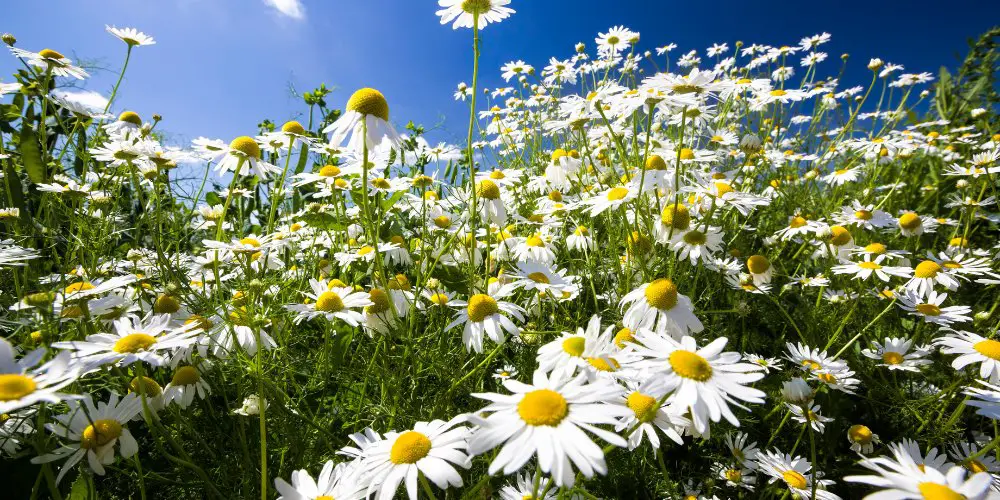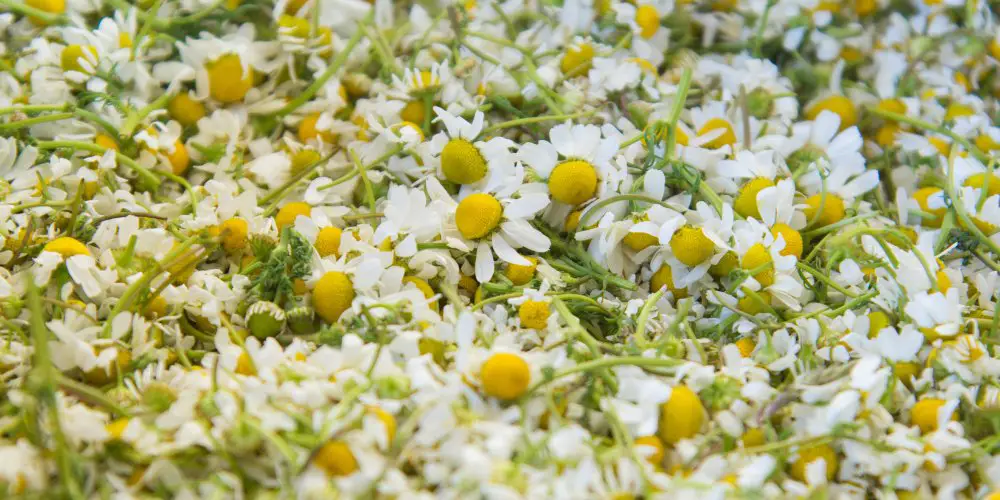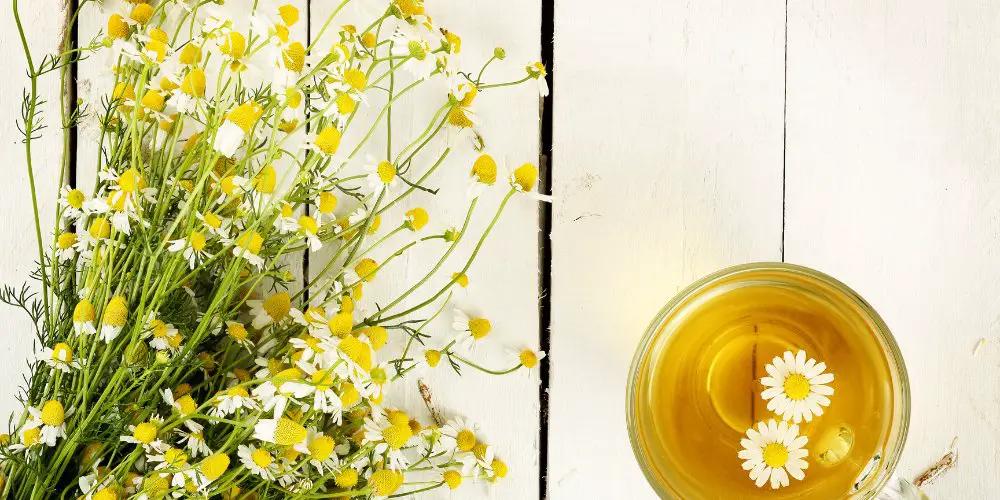When to harvest chamomile for tea?
Growing chamomile is insanely simple! If you are craving a cup of chamomile tea that is made of your own chamomile flowers, there is nothing easier than growing chamomiles in your herb garden.

We are here to share some tips on how to grow and harvest chamomile flowers for making a cup of perfect chamomile tea.
Contents
What do you know about chamomiles?
Growing chamomiles mostly for tea harvesting and enjoying their nice yellow and white flowers, many of us don’t know much about these versatile plants!

Why is chamomile easy to grow?
As you already know, there is nothing tricky about growing chamomile. Among many kitchen herbs, chamomiles are one of the easiest to grow and maintain for several reasons.
Chamomile plants are fast-growers, which means you don’t have to wait for a long time to get a great tea crop.

All that you need for growing chamomile is just a sunny patch in your garden. Make sure that your chamomile flowers get enough sun to grow quickly and eagerly. The soil should be well-drained, or else there is a high risk of over-water your chamomiles.
Don’t be afraid of full sun exposure, as the chamomile plant is drought-tolerant and really likes heat.
One more benefit of growing chamomile in your garden is that it doesn’t need any extra fertilizers. They just prefer well-drained types of soil where they can grow best.
Why plant chamomile?
Chamomile flowers are more than just lovely daisy-like flowers that decorate your garden. Along with an attractive look, chamomile flowers are full of health benefits and other special features. Some of them are inherent parts of our life.

Chamomile tea is not only a great option for relaxing after a long hustling day. Since chamomile is full of medicinal properties, a good idea is to think of improving your health with a help of this wonderful herb.
Here is a list of the main medicinal properties of chamomiles:
- Good for women’s health – chamomile can reduce menstrual pain and help post-menopausal women to slow the development of osteoporosis.
- Maintain skin and hair health – chamomile tea is also a good hair rinse, and dried chamomile flowers can gently treat dry skin areas.
- Reduce pain and inflammation – yep, most of us know for sure that chamomile flowers have great soothing properties. They are widely known for reducing many types of pain, such as rheumatic pain, and being a great mild remedy for inflammation.
- Work as a sedative cure – using chamomile tea as a treatment that helps to relax and easily fall asleep is always a good idea.
- Lower blood sugar levels – for those who suffer from high blood sugar levels, chamomile tea is a good natural way to deal with this health issue.
- Hay fever remedy – in case you have nasty cold symptoms, the steam inhalations of chamomile tea can give you a good relieving effect.
- Treating gastrointestinal problems – think of all-natural treating your upset stomach with a help of chamomile.
- Heart disorders – chamomile is rich in antioxidants that are essential for people with heart issues.
The key point to know is that you should harvest chamomile when it has the highest essential oil content in the flowers.

A good idea is to grow chamomile plants along with your favorite cabbage varieties, as it is a great natural defense against a cabbage moth. With no chemicals and pesticides, you can protect your cabbage with a help of growing chamomile as a companion plant!
Which chamomile flowers are better for tea?
Since there are two main chamomile types, German and Roman chamomile, you can opt for any of them to grow in your herb gardens. Both of them are good for making chamomile tea, and both have their features.

German chamomile is a popular annual herb that is a wild chamomile variety. This is a tall plant that usually reaches up to 24 inches in height. The stems of German chamomile are fern-like, and the flowers are small.
German chamomile is a self-seeding herb, so it can be very invasive. Control the German chamomile growth in your garden, or plant it in separate pots.
Roman chamomile is another perennial herb that is also good for growing in your garden. This variety of chamomile grows lower and reaches about 12 inches tall. However, Roman chamomile has bigger flowers than German chamomile.
Generally, Roman chamomile looks like dill, and you may think that dill pops up in your herb garden unexpectedly until the first flower buds appear.
Is it difficult to maintain chamomile?
If you decide to grow chamomile in your own garden, you will have almost no problems with it. The only drawback of chamomiles is their invasive nature. They are prone to pop up and grow in the most unexpected patches in your garden. However, there is nothing difficult about thinning chamomile plantations.

Sowing chamomile seeds is the easiest task you can imagine. Simply scatter these tiny seeds on the dry soil, just on the surface. You don’t need to cover them with a new layer of soil! Instead, mist them with water as they need it to germinate. Tamp the dampened soil with seeds a bit.
Since chamomile seeds require enough light to grow, it is an optimal way to grow these plants. Don’t cover them with soil and let them germinate in full sun. The results won’t keep you waiting!
While growing chamomile, you should thin it and leave the strongest stems to grow further. Having enough space is crucial for plants to grow high, strong, and healthy.
As a rule, chamomiles start blooming by early summer. Since this time, you should be attentive so as not to miss the best time for harvesting.
What is more, frequent picking of chamomile stimulates and increases new growth. So, the more you harvest, the more you get!
How do you harvest chamomile for chamomile tea?
Harvesting chamomile is easy, fun, and relaxing. You don’t need to use any tools, as you can just snip these flowers by hand.

The tips on how to harvest chamomile are also simple, so let’s get started!
#1. Opt for the best day for harvesting
The best day for harvesting chamomile is a sunny and dry day. Start harvesting no earlier than the morning dew on the flower heads is completely dried.

Check the weather forecast and make sure that no rain is coming soon.
Keep in mind that you can’t harvest wet flower heads, as they will get moldy while air drying. In addition, on dry days, most essential oils in the chamomile reach their peak.
#2. Harvest the flower heads
Harvesting chamomile is not a science. You can find this quite a relaxing job, and quickly get a full container of chamomiles in your hands.

Take the stem of the plant under the flower head with pinched fingers. Position your middle finger and forefinger against the other fingers just under the flower head. Now, you can simply remove the flower head from the stem.
#3. Opt for the full-bloom
When you harvest chamomile blossoms, always remember that a flower head should be at its peak point.

To define this point, look at the flower petals. The blossoms must be fully open when the petals lie flat around the center.
At this stage of blooming, chamomiles are at their peak and the flowers contain most of the essential oils that are beneficial for human health.
Keep in mind that you should harvest chamomile before its white petals begin to curve down and fall off the center.
After you pick chamomile flowers, never forget to clean them from all the dirt and dust that can accumulate on the petals!
#4. Dry chamomile flowers
Drying chamomile flowers is also an essential point, as you should do it right.
Prepare a big plate to place flowers evenly over the surface. You can cover the plate with a towel, which will help the process.

Then, place the clean and fresh blossoms in the dry part of your house. The optimal place is a dry corner with a minimum of sunlight, where you can air-dry chamomile flowers until they are good to go.
If you want to fasten the drying process, dry chamomile flowers in the oven. Set the temperature at about 86 °F (30 °C) so as not to over-dry flowers and decrease their medicinal properties. Let the excess moisture dry out without getting too hot.
You can opt for a food dehydrator instead of an oven. Dry chamomile on the lowest temperature setting.
Keep your dried chamomile flowers in an airtight container or sealed glass jar. It helps to prevent mold and dust accumulation.
What is the best chamomile tea recipe?
Who can resist a steaming cup of chamomile tea? This enjoyable drink helps you to relax, get together with your thoughts, and enjoy a cozy evening in your sweet home.

You can use both dried and fresh flowers for a chamomile tea recipe. However, dried flowers are richer in flavor and oil content.
Try this simple chamomile tea recipe and enjoy a peaceful evening!
Prepare about 8 oz of boiling water, 2-4 tbsp of dried chamomile flowers, and some sugar or honey.
Fill your tea infuser with dried chamomile flowers and place it in the cup.
Pour boiling water into the cup. Let it stay for about 5 minutes, and then take the tea infuser away. Add a sweetener if you wish.
You can optionally add some mint, lemon juice, or other herbs by taste.

FAQ
How do you know when chamomile is ready to harvest?
A crucial point in harvesting chamomile flowers is the position of their petals. They should lay flat around the center of the flower. If you want to get the most medicinal benefits, it is the best time to harvest chamomile flowers.
You can also harvest them a bit earlier or later after that, but their benefits will be lower.
Which part of chamomile is used for tea?
For making chamomile tea, you need to harvest their flower heads. However, their leaves are also edible. You can add them optionally to the teas and some dishes by taste.
Do you have to dry chamomile to make tea?
After you harvest chamomile flowers, you need to dry them well. However, you can make chamomile tea with fresh flowers.
As a variant, you can air dry some chamomile flowers beforehand for brewing, and then add some fresh chamomile flowers or petals on the tea surface.
Final thoughts
As you can see, there is nothing easier than harvesting chamomile for tea.
Share your favorite chamomile tea recipe in the comments!
You can also read: How and when to harvest fennel? — Bulbs, seeds, and flowers



